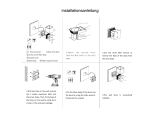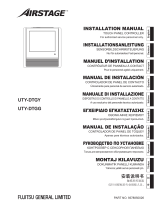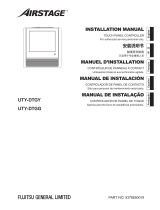
En-1
1. SAFETY PRECAUTIONS
• Be sure to read this Manual thoroughly before installation.
• The warnings and precautions indicated in this Manual contain important information
pertaining to your safety. Be sure to observe them.
• Hand this Manual, together with the Operating Manual, to the customer. Request the
customer to keep them on hand for future use, such as for relocating or repairing the unit.
WARNING
This mark indicates procedures which, if improperly performed,
might lead to the death or serious injury of the user.
Request your dealer or a professional installer to install the indoor unit in accordance
with this Installation Manual. An improperly installed unit can cause serious accidents
such as water leakage, electric shock, or fi re. If the indoor unit is installed in disregard
of the instructions in the Installation Manual, it will void the manufacturer’s warranty.
Do not turn ON the power until all work has been completed. Turning ON the power
before the work is completed can cause serious accidents such as electric shock or
fi re.
If refrigerant leaks while work is being carried out, ventilate the area. If the refrigerant
comes in contact with a fl ame, it produces a toxic gas.
Installation work must be performed in accordance with national wiring standards by
authorized personnel only.
Except for EMERGENCY, never turn off main as well as sub breaker of the indoor
units during operation. It will cause compressor failure as well as water leakage.
First, stop the indoor unit by operating the controller, converter or external input device
and then cut the breaker.
Make sure to operate through the controller, converter or external input device.
When the breaker is designed, locate it at a place where the users cannot start and
stop in the daily work.
CAUTION
This mark indicates procedures which, if improperly performed, might
possibly result in personal harm to the user, or damage to property.
Read carefully all security information before use or install the air conditioner.
Do not attempt to install the air conditioner or a part of the air conditioner by yourself.
This unit must be installed by qualifi ed personnel with a capacity certifi cate for handling
refrigerant fl uids. Refer to regulation and laws in use on installation place.
The installation must be carried out in compliance with regulations in force in the place
of installation and the installation instructions of the manufacturer.
This unit is part of a set constituting an air conditioner. It must not be installed alone or
with non-authorized by the manufacturer.
Always use a separate power supply line protected by a circuit breaker operating on all
wires with a distance between contact of 3 mm for this unit.
The unit must be correctly earthed (grounded) and the supply line must be equipped
with a differential breaker in order to protect the persons.
The units are not explosion proof and therefore should not be installed in explosive
atmosphere.
Never touch electrical components immediately after the power supply has been turned
off. Electric shock may occur. After turning off the power, always wait 5 minutes before
touching electrical components.
This unit contains no user-serviceable parts. Always consult authorized service person-
nel to repairs.
When moving, consult authorized service personnel for disconnection and installation
of the unit.
2. ABOUT THIS PRODUCT
2.1. Precautions for using R410A refrigerant
WARNING
Do not introduce any substance other than the prescribed refrigerant into the
refrigeration cycle. If air enters the refrigeration cycle, the pressure in the refrigeration
cycle will become abnormally high and cause the piping to rupture.
If there is a refrigerant leak, make sure that it does not exceed the concentration limit.
If a refrigerant leak exceeds the concentration limit, it can lead to accidents such as
oxygen starvation.
Do not touch refrigerant that has leaked from the refrigerant pipe connections or other
area. Touching the refrigerant directly can cause frostbite.
If a refrigerant leak occurs during operation, immediately vacate the premises and
thoroughly ventilate the area. If the refrigerant comes in contact with a flame, it
produces a toxic gas.
2.2. Special tool for R410A
WARNING
To install a unit that uses R410A refrigerant, use dedicated tools and piping materials
that have been manufactured specifically for R410A use. Because the pressure
of R410A refrigerant is approximately 1.6 times higher than the R22, failure to
use dedicated piping material or improper installation can cause rupture or injury.
Furthermore, it can cause serious accidents such as water leakage, electric shock, or
fi re.
Tool name Changes
Gauge manifold
The pressure in the refrigerant system is extremely high
and cannot be measured with a conventional (R22)
gauge. To prevent erroneous mixing of other refriger-
ants, the diameter of each port has been changed. It
is recommended to use a gauge manifold with a high
pressure display range of –0.1 to 5.3 MPa and a low pres-
sure display range of –0.1 to 3.8 MPa.
Charging hose
To increase pressure resistance, the hose material and
base size were changed.
(The charging port thread diameter for R410A is 1/2 UNF
20 threads per inch.)
Vacuum pump
A conventional (R22) vacuum pump can be used by install-
ing a vacuum pump adapter.
Be sure that the pump oil does not backfl ow into the sys-
tem. Use one capable for vacuum suction of –100.7 kPa (5
Torr, –755 mmHg).
Gas leakage detector
Special gas leakage detector for R410A refrigerant.
INSTALLATION MANUAL
PART NO. 9373370260
VRF system indoor unit (Wall mounted type)
Contents
1. SAFETY PRECAUTIONS ........................................................................................... 1
2. ABOUT THIS PRODUCT ............................................................................................ 1
2.1. Precautions for using R410A refrigerant .................................................................. 1
2.2. Special tool for R410A .......................................................................................... 1
2.3. Accessories .......................................................................................................... 2
2.4. Optional parts ....................................................................................................... 2
3. INSTALLATION WORK .............................................................................................. 2
3.1. Selecting an installation location .......................................................................... 2
3.2. Installation dimension ........................................................................................... 2
3.3. Installing the unit ................................................................................................... 3
4. PIPE INSTALLATION .................................................................................................. 4
4.1. Selecting the pipe material ................................................................................... 4
4.2. Pipe requirement .................................................................................................. 4
4.3. Flare connection (pipe connection) ...................................................................... 4
5. FORMING THE DRAIN HOSE AND PIPE .................................................................. 5
6. ELECTRICAL WIRING ................................................................................................ 6
6.1. Electrical requirement ........................................................................................... 6
6.2. Wiring method ...................................................................................................... 7
6.3. Unit wiring ............................................................................................................. 7
6.4. Wiring.................................................................................................................... 8
6.5. External input and external output (Optional parts) .............................................. 8
7. FIELD SETTING ........................................................................................................ 10
7.1. Setting the address ............................................................................................. 10
7.2. Custom code setting ........................................................................................... 12
7.3. Function setting .................................................................................................. 12
8. FINISHING................................................................................................................. 13
8.1. Connection pipe, cable and drain hose .............................................................. 13
8.2. Installing front cover ........................................................................................... 14
9. TEST RUN ................................................................................................................. 15
9.1. Test run using Outdoor unit (PCB) ...................................................................... 15
9.2. Test run using remote controller ......................................................................... 15
10. CHECK LIST ............................................................................................................. 15
11. ERROR CODES ........................................................................................................ 15




















